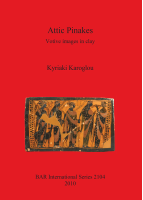Description
BOOK DESCRIPTIONIn modern studies pinax refers to a flat, rectangular, painted slab of clay placed in a sanctuary or tomb. In this study the author presents the various occurrences and possible meanings of the word pinax in the sources and examines the representation ofpinakes on vases. A synthesis of pinakes is much needed since it can provide valuable information about ancient Greek religious and social practices. To this end, this book by concentrating on Attic pinakes fills a substantial gap in scholarship since Attic pinakes have not been methodically studied before, although they form one of the largest corpora of pinakes, and are hence a rich and reliable source of information. Chapter one examines the terminology, usage, and placement of pinakes drawing upon ancient testimonia found in literary sources, inscriptions, and representations in vase-painting. This chapter focuses on pinakes as a special category of offering regardless of the material of manufacture, be it wood, metal, or clay. Chapter two presents the corpus of surviving Attic pinakes. A discussion of their archaeological context is followed by an analysis of their iconographic themes in relation to Attic vase-painting in general and in conjunction with various contemporary Attic cults. Chapter three considers the inscriptions, techniques of manufacture, and decoration of Attic pinakes, as well as the attributions to Attic black-figure and red-figure painters. Questions of import, circulation, and dating are also addressed. Chapter four places the dedication of pinakes in the context of Athenian 'votive religion' and society by correlating them with other classes of votives dedicated in Attic sanctuaries, notably the Athenian Acropolis. By examining the iconography of genre scenes on Attic pinakes in light of current modes of representation of specific social groups, chapter four contributes to a sociology of dedication in ancient Greece, an under-explored subject of inquiry. Finally, an appendix correlates the Corinthian pinakes from Penteskouphia and the Potters' Quarter with the Attic material.











